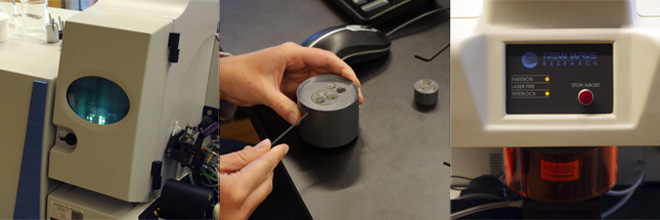LA-ICPMS U-Pb geochronology + trace elements

Microbeam analysis of zircon U-Th-Pb isotope systematics and trace element compositions is a routine task in the ICPMS facility using the ThermoElectron X-Series II quadrupole ICPMS and New Wave Research UP-213 Nd:YAG UV (213 nm) laser ablation system. We have applied for over a decade customized analytical protocols, standard materials and data reduction software for automated, simultaneous acquisition and real-time calibration of U-Th-Pb ages and a suite of HFSE and REE elements. More recently the addition of a second interface pump has given us a doubling of the sensitivity of the system.
Zircons are ablated using spot (25 µm aperture, 5 J/cm2 fluence, 5 Hz firing repetition) and line (12 µm aperture, 2 µm/s raster rate, 8 J/cm2 fluence, 10 Hz firing repetition) geometries during a 45 second analysis (15 sec gas blank, 30 sec ablation) that penetrates approximately 1 µm/sec. Ablated material is carried by a 1 L/min He gas stream to the plasma. Dwell times are 5 ms for Si and Zr; 40 ms for 49Ti, 238U, 232Th, 202Hg, and all Pb isotopes; and 10 ms all other HFSE and REE elements. Background count rates for each analyte are obtained prior to each spot analysis and subtracted from the raw count rate for each analyte. For concentration calculations, background-subtracted count rates for each analyte are internally normalized to 29Si, and calibrated with respect to NIST 610 and 612, or USGS BCR-2 and BIR-1 glasses as the primary standards.
For U-Th-Pb age analysis, instrumental fractionation of the background-subtracted 206Pb/238U, 207Pb/206Pb, and 208Pb/232Th ratios is corrected, and ages calibrated with respect to interspersed measurements of the Plesovice zircon standard (Slama et al., 2008). Signals at mass 204 are indistinguishable from zero following subtraction of mercury backgrounds measured during the gas blank (< 1000 cps 202Hg), thus ages are reported without common Pb correction; however, age error propagation includes an uncertainty contribution due to common Pb using the absolute value of the measured 206Pb/204Pb ratio. Radiogenic isotope ratio and age error propagation for each detrital grain analysis includes uncertainty contributions from counting statistics, background subtraction, common Pb correction, and standard calibration (based on the standard deviation of the isotope ratio measurements of the standard over the course of the experiment). Error propagation for non-detrital spot analyses exclude standard calibration uncertainty, which is instead propagated in quadrature following group statistics (e.g. weighted mean calculations); standard calibration uncertainties range from 1-2% (2s) for a given experiment.